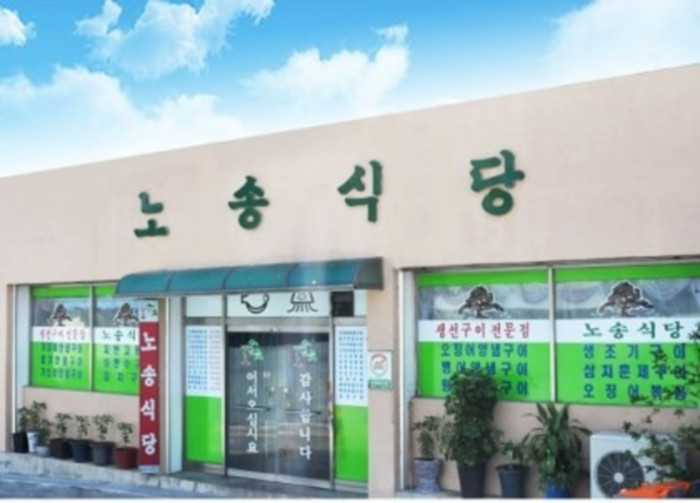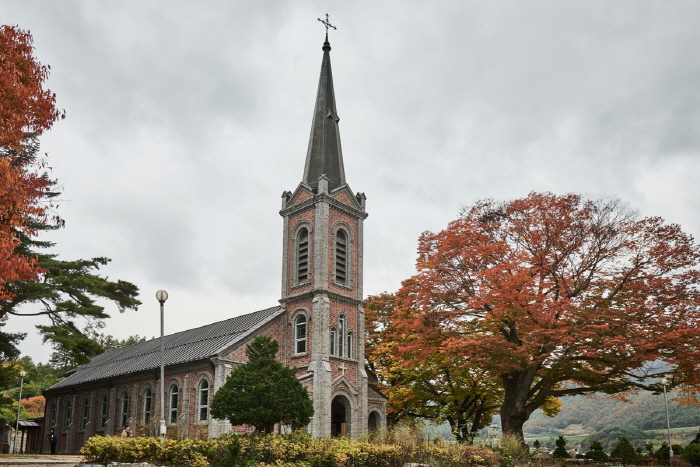Nosong Sikdang (노송식당)
9.0Km 2024-02-23
5, Naeto-ro, 43-gil, Jecheon-si, Chungcheongbuk-do
+82-43-647-4752
Nosong Sikdang, a celebrated grilled fish restaurant with a tradition spanning over 30 years, is so well-regarded that diners often wait for a table. It offers two varieties of grilled fish: marinated and simply grilled. The gajami yangnyeom gui (grilled marinated plaice) comes highly recommended. Beyond this specialty, guests can savor other seafood delights including goldeye rockfish, ray, dried pollack, and silver pomfret. Additionally, muneo sukhoe (parboiled octopus) and ojingeo bokkeum (stir-fried squid) are popular choices among visitors.
Yongsomak Catholic Church (용소막성당)
9.0Km 2023-07-17
1857 Guhaksan-ro Sillim-myeon, Wonju-si, Gangwon-do
Yongsomak Catholic Church is a small church located in Sillim-myeon, Wonju and designated as a Tangible Cultural Heritage of Gangwon-do. It was the third Catholic church established in Gangwon-do after Pungsuwon Catholic Church and Wonju Catholic Church. It was constructed by Father Chizallet in 1915 and, today, it is over 90 years of age.
Zelkova trees line up around the church building and the statue of the Virgin Mary stands at the bottom of a hill to the left. A thickly wooded pine forest is seen over the statue and the Relic Museum of St. Lawrence, which is an auxiliary building of the cathedral, is seated by the forest. The look of an old countryside Catholic church built with red bricks is like a scene from a painting, exuding a solemn and grave atmosphere in this religious area.
Pyeonbaek Sanghoe Jecheon Branch (편백상회 제천점)
9.3Km 2025-10-23
146 Myeongnyun-ro, Jecheon-si, Chungcheongbuk-do
Pyeonbaeksanghoe Jecheon is an all-you-can-eat shabu-shabu restaurant located in Gyodong, Jecheon-si, Chungcheongbuk-do. It has a menu that allows customers to enjoy cypress-steamed dishes, shabu shabu, Vietnamese spring rolls, and a salad bar all in one place. The restaurant is characterized by serving fresh vegetables and first-grade meat. The spacious parking lot is convenient for groups and tourist vehicles, and the comfortable interior is suitable for families and groups. Private rooms are available for private dining, and there is a playroom for children, making it a great place to visit with kids. Fresh ingredients are airlifted in every morning, and meals are served in a clean and hygienic environment.
Uirimji Reservoir (제천 의림지와 제림)
9.6Km 2024-07-31
33 Uirimji-ro, Jecheon-si, Chungcheongbuk-do
+82-43-651-7101
Uirimji Reservoir was created during the Three Kingdoms Era. Due to its long history, it is one of the most famous reservoirs in Chungcheong-do.
The reservoir is 1.8 kilometers in circumference and 151,470 square meters in water surface area and has a depth of 8-13 meters. It supplies water to nearby farmland and was one of the 3 major reservoirs of the Three Kingdoms Era along with Byeokgolje of Gimje and Susanje of Miryang. With a water gate built of onggi (earthenware), Uirimji is also a valuable historical site for studying farming methods.
The reservoir is one of the main tourist attractions of Jecheon. Attractions around the reservoir include Yeonghojeong Pavilion and Gyeonghoru Pavilion. The traditional beauty of the structures is accented by the neighboring ancient pine and willow trees and the 30 meter-high waterfall.
E-Mart - Jecheon Branch [Tax Refund Shop] (이마트 제천)
9.9Km 2024-04-17
11, Jangpyeongcheon-ro, Jecheon-si, Chungcheongbuk-do
-
Mosan Airfield (모산비행장)
10.1Km 2025-10-29
Goam-dong, Jecheon-si, Chungcheongbuk-do
BTS‘EPILOGUE Young Forever’
This is the endless runway where the 7 members of BTS walked side by side. It was built for flight training in the past, but is now being used as a public park. Depending on the season, there is a flower field where sunflowers, verbena, crape myrtle, and pink muhly are in full bloom, so it is perfect for viewing and taking pictures. There are cafes around the runway to add a break to sightseeing.
Geumwolbong Peak (금월봉)
10.3Km 2024-02-26
1316 Cheongpungho-ro, Geumseong-myeon, Jecheon-si, Chungcheongbuk-do
Geumwolbong Peak is a unique, small rocky mountain distinguished by its diverse shapes that blend a touch of artificiality with natural beauty. This site, initially a limestone mine, unveiled its striking rock formations in 1993. The resemblance of these rocks to the Manmulsang (Ten Thousand Rocks) of North Korea's Geumgangsan Mountain earned it the nickname "Little Geumgangsan Mountain." It was later officially renamed Geumwolbong Peak.
Jecheon Baengnyeonsa Temple (백련사(제천))
10.7Km 2021-10-25
414, Myeongam-ro 5-gil, Jecheon-si, Chungcheongbuk-do
+83-43-653-4996
Baengnyeonsa Temple is located at the foothills of Gamaksan Mountain in Jecheon, Chungcheongbuk-do. The temple is currently composed of the main hall Daeungjeon, Samseonggak Shrine, Muyeomdang Hall, Boeungmun Gate, and residential houses. Daeungjeon Hall enshrines a wooden statue of a sitting Buddha, is an artifact from the Joseon period (1392-1910).
The history of the temple dates back to 662 (the second year of King Munmu’s reign during the Silla Kingdom), when a small shrine called Baengnyeonam Hermitage was built by the great monk Uisang on the east side of Baengyeonji Site. The temple has been reconstructed and restored numerous times throughout the course of several wars. The temple once encompassed many branch temples and shrines such as Mireuksa, Sinheungsa, Cheonsuam, Eunjeokam, and Cheongnyeonam, but only their foundation sites remain today.
Songpungjae (송풍재)
13.4Km 2024-02-22
65 Saetgangyeong-gil, Sancheok-myeon, Chungju-si, Chungcheongbuk-do
Songpungjae is a bean curd specialty restaurant located in Chungju. Housed in a hanok building, it offers an ambiance that reflects the beauty of Korea. Bean curd, made from soybeans, is the main ingredient here, with the unique feature of being cultivated directly on-site. Their signature dish is sondubu jeongol (handmade bean curd hot pot), while their jjageuri (pork stew), and ori cheolpan gui (stir-fried duck on hot iron plate) are also popular choices. It takes about 20 minutes by car from Tangeumdae Overlook of Chungju to reach the restaurant.
Woodblock Printing Museum (고판화박물관)
13.8Km 2023-07-17
62 Muran-gil, Wonju-si, Gangwon-do
Opened in 2004, it is the only museum in Korea that specializes in and exhibits old woodblock printings from all around the world. Woodblock Printing Museum collects, stores, exhibits, researches and educates on ancient woodblock materials from many different Asian countries where engravings and woodcuts flourished including Korea, China, Japan, Tibet, Mongolia, India and Nepal. It currently stores over 3,500 individual relics including some 1,800 original woodblocks, 300 old woodblock works engraved as woodcuts, 200 books engraved on woodblocks, and 200 materials related to woodcuts. There is also a permanent woodblock experience hall, which is often utilized as a place to experience and educate those on site who are not satisfied with just seeing the works.



![E-Mart - Jecheon Branch [Tax Refund Shop] (이마트 제천)](http://tong.visitkorea.or.kr/cms/resource/38/2882938_image2_1.jpg)


 English
English
 한국어
한국어 日本語
日本語 中文(简体)
中文(简体) Deutsch
Deutsch Français
Français Español
Español Русский
Русский